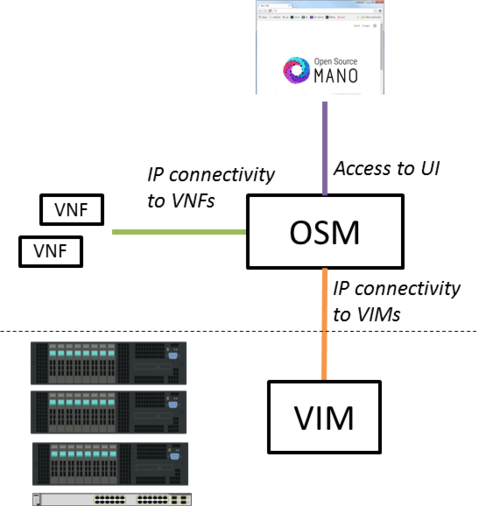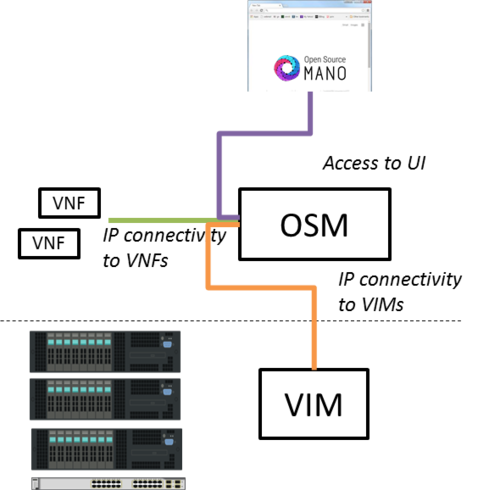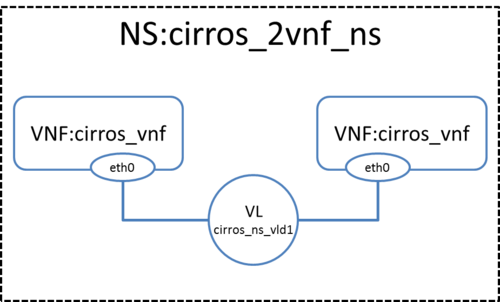Talk: OSM Release ONE: Difference between revisions
Garciadeblas (talk | contribs) |
Garciadeblas (talk | contribs) No edit summary |
||
| Line 1: | Line 1: | ||
OSM is | Open Source MANO (OSM) is the open source community that aims to deliver a production-quality MANO stack for NFV, capable of consuming openly published information models, available to everyone, suitable for all VNFs, operationally significant and VIM-independent. OSM is aligned to NFV ISG information models while providing first-hand feedback based on its implementation experience. | ||
__TOC__ | |||
==Interaction with VIMs and VNFs== | |||
The following figure shows OSM interaction with VIM and VNFs. | The following figure shows OSM interaction with VIM and VNFs. | ||
[[File:OSMconnectivity1.png|500px|OSM Release 1 connectivity]] | [[File:OSMconnectivity1.png|500px|OSM Release 1 connectivity 1]] | ||
In simpler setups, OSM only requires a single interface as long as both VIM and VNF IP addresses are reachable | |||
[[File:OSMconnectivity2.png|500px|OSM Release 1 connectivity]] | [[File:OSMconnectivity2.png|500px|OSM Release 1 connectivity 2]] | ||
==Install OSM== | ==Install OSM== | ||
| Line 29: | Line 30: | ||
==Adding a VIM account== | ==Adding a VIM account== | ||
Before proceeding, make sure that you have a VIM configured to run with OSM. Three different kinds of VIMs are currently supported by OSM: | Before proceeding, make sure that you have a VIM configured to run with OSM. Three different kinds of VIMs are currently supported by OSM: | ||
*[[OpenVIM installation (Release One) | *OpenVIM. Check the following link to know how to install and use openvim for OSM: [[OpenVIM installation (Release One)]] | ||
*OpenStack | *OpenStack. Check the following link to learn how to configure OpenStack to be used by OSM: [[Openstack configuration (Release ONE]] | ||
*[[Configuring VMware vCloud Director for OSM Release One | *VMware vCloud Director. Check the following link to learn how to configure VMware VCD to be used by OSM: [[Configuring VMware vCloud Director for OSM Release One]] | ||
===OpenVIM DC=== | |||
*Go into the RO container: | |||
lxc exec RO -- bash | |||
*Execute the following commands, using the appropriate parameters (e.g. site name: "openvim-site", IP address: 10.10.10.10, VIM tenant: "osm") | |||
export OPENMANO_TENANT=osm | |||
openmano datacenter-create openvim-site http://10.10.10.10:9080/openvim --type openvim --description "Openvim Datacenter" | |||
openmano datacenter-attach openvim-site --vim-tenant-name=osm | |||
openmano datacenter-list | |||
===OpenStack DC=== | |||
*Go into the RO container: | |||
lxc exec RO -- bash | |||
*Execute the following commands, using the appropriate parameters (e.g. site name: "openstack-site", IP address: 10.10.10.11, VIM tenant: "admin", user: "admin", password: "userpwd") | |||
export OPENMANO_TENANT=osm | |||
openmano datacenter-create openstack-site http://10.10.10.11:5000/v2.0 --type openstack --description "OpenStack Datacenter" | |||
openmano datacenter-attach openstack-site --user=admin --password=userpwd --vim-tenant-name=admin | |||
openmano datacenter-list | |||
===VMware DC=== | |||
*Go into the RO container: | |||
lxc exec RO -- bash | |||
*Execute the following commands, using the appropriate parameters (e.g. site name: "vmware-site", IP address: 10.10.10.12, VIM tenant: "vmware-tenant", user: "osm", password: "osm4u", admin user: "admin", admin password: "adminpwd") | |||
openmano datacenter-create vmware-site https://10.10.10.12" --type vmware --description "VMware Datacenter" --config '{admin_password: adminpwd, admin_username: admin}' | |||
openmano datacenter-attach vmware-site --user=osm --password=osm4u --vim-tenant-name=vmware-tenant | |||
openmano datacenter-list | |||
Note: The name of the datacenter "vmware-site" has to match the name of the organization of "vCloud Director". Inside this organization the tenant "vmware-tenant" must exist | Note: The name of the datacenter "vmware-site" has to match the name of the organization of "vCloud Director". Inside this organization the tenant "vmware-tenant" must exist | ||
| Line 69: | Line 79: | ||
===Onboarding a VNF=== | ===Onboarding a VNF=== | ||
* | *From the UI: | ||
**Go to Catalog | |||
**Click on the import button | |||
**Drag and drop the VNF package file cirros_vnf.tar.gz in the importing area. | |||
*From the SO CLI: | |||
**To be filled | |||
===Onboarding a NS=== | ===Onboarding a NS=== | ||
* | *From the UI: | ||
**Go to Catalog | |||
**Click on the import button | |||
**Drag and drop the NS package file cirros_2vnf_ns.tar.gz in the importing area. | |||
*From the SO CLI: | |||
**To be filled | |||
===Instantiating the NS=== | ===Instantiating the NS=== | ||
* | *From the UI: | ||
**Go to ... | |||
**Click on ... | |||
**Drag and drop the NS package file cirros_2vnf_ns.tar.gz in the importing area. | |||
*From the SO CLI: | |||
**To be filled | |||
Wait for the message that the NS has been successfully deployed, and that's all!!! | Wait for the message that the NS has been successfully deployed, and that's all!!! | ||
| Line 84: | Line 109: | ||
*[[Release ONE Creating your own VNF package|Creating your own VNF package]] | *[[Release ONE Creating your own VNF package|Creating your own VNF package]] | ||
*[[Release ONE Logs and troubleshooting|Logs and troubleshooting]] | *[[Release ONE Logs and troubleshooting|Logs and troubleshooting]] | ||
*[[Release | *[[Release ONE Data Model details|Data Model Details]] | ||
*[https://osm.etsi.org/images/OSM-Whitepaper-TechContent-ReleaseONE-FINAL.pdf OSM White Paper - Release ONE Technical Overview] | *[https://osm.etsi.org/images/OSM-Whitepaper-TechContent-ReleaseONE-FINAL.pdf OSM White Paper - Release ONE Technical Overview] | ||
*[[Release | *[[Release ONE Technical FAQ|Technical FAQ]] | ||
Revision as of 09:27, 25 October 2016
Open Source MANO (OSM) is the open source community that aims to deliver a production-quality MANO stack for NFV, capable of consuming openly published information models, available to everyone, suitable for all VNFs, operationally significant and VIM-independent. OSM is aligned to NFV ISG information models while providing first-hand feedback based on its implementation experience.
Interaction with VIMs and VNFs
The following figure shows OSM interaction with VIM and VNFs.
In simpler setups, OSM only requires a single interface as long as both VIM and VNF IP addresses are reachable
Install OSM
Install from source
All you need to run OSM Release One is a single server or VM with the following requirements:
- 8 CPUs, 16 GB RAM, 100GB disk and a single interface with Internet access
- Ubuntu16.04 as base image, configured to run LXD containers. If you don't have LXD configured, you can follow the instructions here (LXD configuration)
Once you have prepared the host with the previous requirements, all you need to do is:
wget https://osm-download.etsi.org/ftp/osm-1.0-one/install_from_source.sh chmod +x install_from_source.sh ./install_from_source.sh
After some time, you will get a fresh OSM Release One installation. You can access to the UI in the following URL (user:admin, password: admin):
https://your_local_ip:8443
Adding a VIM account
Before proceeding, make sure that you have a VIM configured to run with OSM. Three different kinds of VIMs are currently supported by OSM:
- OpenVIM. Check the following link to know how to install and use openvim for OSM: OpenVIM installation (Release One)
- OpenStack. Check the following link to learn how to configure OpenStack to be used by OSM: Openstack configuration (Release ONE
- VMware vCloud Director. Check the following link to learn how to configure VMware VCD to be used by OSM: Configuring VMware vCloud Director for OSM Release One
OpenVIM DC
- Go into the RO container:
lxc exec RO -- bash
- Execute the following commands, using the appropriate parameters (e.g. site name: "openvim-site", IP address: 10.10.10.10, VIM tenant: "osm")
export OPENMANO_TENANT=osm openmano datacenter-create openvim-site http://10.10.10.10:9080/openvim --type openvim --description "Openvim Datacenter" openmano datacenter-attach openvim-site --vim-tenant-name=osm openmano datacenter-list
OpenStack DC
- Go into the RO container:
lxc exec RO -- bash
- Execute the following commands, using the appropriate parameters (e.g. site name: "openstack-site", IP address: 10.10.10.11, VIM tenant: "admin", user: "admin", password: "userpwd")
export OPENMANO_TENANT=osm openmano datacenter-create openstack-site http://10.10.10.11:5000/v2.0 --type openstack --description "OpenStack Datacenter" openmano datacenter-attach openstack-site --user=admin --password=userpwd --vim-tenant-name=admin openmano datacenter-list
VMware DC
- Go into the RO container:
lxc exec RO -- bash
- Execute the following commands, using the appropriate parameters (e.g. site name: "vmware-site", IP address: 10.10.10.12, VIM tenant: "vmware-tenant", user: "osm", password: "osm4u", admin user: "admin", admin password: "adminpwd")
openmano datacenter-create vmware-site https://10.10.10.12" --type vmware --description "VMware Datacenter" --config '{admin_password: adminpwd, admin_username: admin}' openmano datacenter-attach vmware-site --user=osm --password=osm4u --vim-tenant-name=vmware-tenant openmano datacenter-list
Note: The name of the datacenter "vmware-site" has to match the name of the organization of "vCloud Director". Inside this organization the tenant "vmware-tenant" must exist
Deploying your first Network Service
In this example we will deploy the following Network Service, consisting of two simple VNFs based on CirrOS connected by a simple VLD.
Before going on, download the required VNF and NS packages from this URL: https://osm-download.etsi.org/ftp/examples/cirros_2vnf_ns/
Uploading VNF image to the VIM
Get the cirros 0.3.4 image from the following link: http://download.cirros-cloud.net/0.3.4/cirros-0.3.4-x86_64-disk.img
Then, onboard the image into the VIM. The instruction differs from one VIM to another:
- In Openstack:
openstack image create --file="./cirros-0.3.4-x86_64-disk.img" --container-format=bare --disk-format=qcow2 --public --property location="/mnt/powervault/virtualization/osm/CirrOS/cirros-0.3.4-x86_64-disk.img" cirros034
- In openvim:
openvim image-create --name cirros034 --path /mnt/powervault/virtualization/osm/CirrOS/cirros-0.3.4-x86_64-disk.img
Onboarding a VNF
- From the UI:
- Go to Catalog
- Click on the import button
- Drag and drop the VNF package file cirros_vnf.tar.gz in the importing area.
- From the SO CLI:
- To be filled
Onboarding a NS
- From the UI:
- Go to Catalog
- Click on the import button
- Drag and drop the NS package file cirros_2vnf_ns.tar.gz in the importing area.
- From the SO CLI:
- To be filled
Instantiating the NS
- From the UI:
- Go to ...
- Click on ...
- Drag and drop the NS package file cirros_2vnf_ns.tar.gz in the importing area.
- From the SO CLI:
- To be filled
Wait for the message that the NS has been successfully deployed, and that's all!!!


